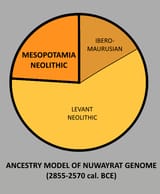Search results for "775175a072a6ea99e9fd4943986280bd" in md5 (2)
Anonymous
 8/28/2025, 12:03:15 AM
No.514161720
8/28/2025, 12:03:15 AM
No.514161720
>>514161676
>The genetic profile of the Nuwayrat individual was most closely represented by a two-source model, in which 77.6%±3.8% of the ancestry corresponded to genomes from the Middle Neolithic Moroccan site of Skhirat-Rouazi (SKH, dated to 4780–4230 BCE), consisting of predominantly (76.4±4.0%) Levant Neolithic ancestry and (22.4±3.8%) minor Iberomaurusian ancestry, with the remaining (22.4%±3.8%) most closely related to known genomes from Neolithic Mesopotamia (dated to 9000-8000BCE). No other two-source model met the significance criteria (P>0.05). A total of two Three-source models also emerged, but had similar ancestry proportions, with the addition of a much smaller third-place component from the Neolithic/Chalcolithic Levant
>According to Lazardis, “What this sample does tell us is that at such an early date there were people in Egypt that were mostly North African in ancestry, but with some contribution of ancestry from Mesopotamia". According to Girdland-Flink, the fact that 20% of the man’s ancestry best matches older genomes from Mesopotamia suggests a fairly substantial diffusion of Mesopotamian-related people into Egypt
>Most of the genome of the Nuwayrat individual (about 78%) derived from Neolithic North African ancestry, specifically matching samples from the Moroccan site of Skhirat-Rouazi (SKH, dated to 4780–4230 BCE). This seems to reflect shared Neolithic ancestry across North Africa during this period, and its specific genetic contribution to the Early Dynastic and Old Kingdom people. However this shared Neolithic North African ancestry itself has been previously shown to be a combination of Levant Neolithic ancestry for about 76%, probably reflecting one or several pre-Bronze Age Levantine migration events, and Iberomaurusian ancestry for about 24%
Anonymous
8/20/2025, 5:03:01 AM
No.17935906
>>17935899
>The genetic profile of the Nuwayrat individual was most closely represented by a two-source model, in which 77.6%±3.8% of the ancestry corresponded to genomes from the Middle Neolithic Moroccan site of Skhirat-Rouazi (SKH, dated to 4780–4230 BCE), consisting of predominantly (76.4±4.0%) Levant Neolithic ancestry and (22.4±3.8%) minor Iberomaurusian ancestry, with the remaining (22.4%±3.8%) most closely related to known genomes from Neolithic Mesopotamia (dated to 9000-8000BCE). No other two-source model met the significance criteria (P>0.05). A total of two Three-source models also emerged, but had similar ancestry proportions, with the addition of a much smaller third-place component from the Neolithic/Chalcolithic Levant
>According to Lazardis, “What this sample does tell us is that at such an early date there were people in Egypt that were mostly North African in ancestry, but with some contribution of ancestry from Mesopotamia". According to Girdland-Flink, the fact that 20% of the man’s ancestry best matches older genomes from Mesopotamia suggests a fairly substantial diffusion of Mesopotamian-related people into Egypt
>Most of the genome of the Nuwayrat individual (about 78%) derived from Neolithic North African ancestry, specifically matching samples from the Moroccan site of Skhirat-Rouazi (SKH, dated to 4780–4230 BCE). This seems to reflect shared Neolithic ancestry across North Africa during this period, and its specific genetic contribution to the Early Dynastic and Old Kingdom people. However this shared Neolithic North African ancestry itself has been previously shown to be a combination of Levant Neolithic ancestry for about 76%, probably reflecting one or several pre-Bronze Age Levantine migration events, and Iberomaurusian ancestry for about 24%

